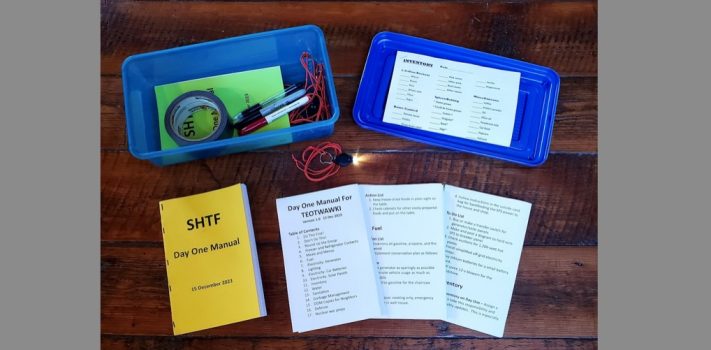by St. Funogas, Survival Blog:

(Continued from Part 2.)
5. Meals and Menus for Day One and First Week
This may seem like a silly priority item but read on. There term “menu” is being used very loosely.
My DOM Action List
1. Keep freeze-dried foods in plain sight on the table.
2. Check cabinets for other easily-prepared foods and put on the table.
First and foremost: Do NOT open the fridge/freezer to get food for meals!
TRUTH LIVES on at https://sgtreport.tv/
During my 10-day preps test I lost 6 lbs (and I’m not overweight to begin with) mostly because I was so busy and didn’t want to have to think about what food to prepare. It wasn’t until later in the week I remembered those two cases freeze-dried foods in the closet. One more testament to the fact that in the rush of Day One and the first week, it’s hard to think outside of “normal” and important things can be overlooked. During the rest of the trial I ate freeze-dried stroganoff twice a day. Having a list of foods ahead of time and setting them on the table or grouping them in a designated cabinet will prevent this from happening next time.
Menu – If someone is specifically put in charge of meal preparation things will go a lot more smoothly. The larger the group the more important this will be. The rest can worry about how to get the homestead organized and systems in place. Pressure canning should be going day and night in shifts until the freezer contents are all preserved. With this in mind, meal preps should not require stove use while the canning crew is working. The menus should be simple and easily prepared using preps like freeze-dried foods and MREs.
6. Fuel
My DOM Action List
1. Inventory all gasoline, propane, and fire wood
2. Implement conservation plan as follows:
Gasoline
1. Use generator as sparingly as possible
2. Eliminate vehicle usage as much as possible
3. Prioritize gasoline for the chainsaw
Propane
1. Status quo: cooking only, emergency heating in well house.
Firewood
1. Keep the house cooler, no fire until temp below 58°
2. No fire when sleeping, more blankets
3. Use watch caps, hoodies, sweaters, and rechargeable electric hoodies and socks
4. Stack firewood against the house for defense
Check gasoline inventory – Use first for freezer until food processed. Unless 120-v and solar water-pumping plans have already been implemented (planned for May 2024), gasoline will have to be conserved almost exclusively for pumping water to fill my 500-gallon tank. If my solar pump is in place, the only practical long-term use for gasoline will be for running the chain saw.
Check propane quantity – The only practical use will be for cooking. Heating is out of the question. The number of BTU’s my 30-gallon water heater uses for one cycle uses as much propane as my medium stove burner on medium heat for just shy of four hours.
Inventory firewood – Determine how long the existing supply will last under grid-down conditions vs normal conditions.
Begin immediately implementing firewood conservation strategies – home temperatures in the high 50’s low 60’s during the day, and in my area the house only rarely gets below 52°F at night. Use extra blankets on the beds at night. During the day, sweaters and hoodies will be a must. Knitted hats such as watch caps conserve a lot of body heat and are one of the best cost/benefit investments for preppers.
My DOM To-Do List
1. Keep all propane tanks full, don’t wait to fill all at once.
2. Start now replacing small-engine equipment with electric for use with solar-panel electricity
3. Buy electric chainsaw
4. More blankets and sleeping bags for additional housemates.
7. Electricity: Portable Generator
During my ten-day preps test, my habit of putting the “pro” in procrastination and failure to test monthly left me without my generator. Fortunately, the grid-down capability of my grid-tied solar panels took up most of the slack. Unfortunately, they couldn’t provide the most important prepping item of all: water. As luck would have it, my 500-gallon water tank was already 70% full on Day One so I made it through the 10-day trial without needing to refill it.
Generators are another area where an irreplaceable resource like gasoline is easily wasted for conveniences like lighting a heating water instead of sticking to necessities. This is another area where a good DOM will help.
Research your generator specs (or one you plan to buy) to find out how many hours it will run on a gallon of gas. As a specific example, per its spec sheet a Honda 2200-watt generator will run for 3.2 to 8.1 hours depending on how many devices are drawing electricity from it. If the only gasoline you have is the 9½ gallons in the gas tank of your car, that doesn’t give you much run time so plan accordingly and prioritize.
Beware: if considering buying a generator beware of so-called “solar generators.” These aren’t actually generators so be sure the generator you are considering has a gasoline or diesel engine. Before purchasing, research generator variables to consider what to look such as 120-v/220-v capability and wattage capacity for your situation.
Connecting a portable generator to a home wiring system
For those with a portable generator it pays to learn how to connect your generator to your house wiring. It’s a simple inexpensive procedure if you understand the basics of house wiring, a potentially deadly one if you don’t.
My grid-down method uses a cord with a male plug on one end and a 220-v breaker on the other. The main breaker must be shut off even if the grid is history. My service has a disconnect lever below the meter which I can turn off and lock in place. With my generator-connect cord, the breaker end is inserted into my main breaker panel, ground and neutral wires attached, and the other end of the cord is plugged into the generator. The generator ground wire is attached to a ground rod. The procedure takes about ten minutes.




